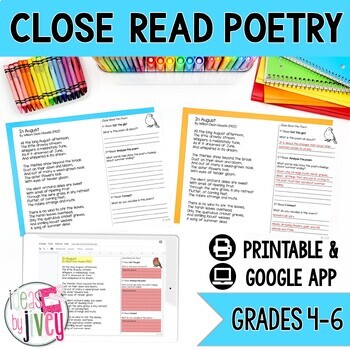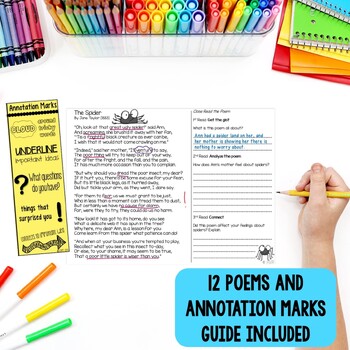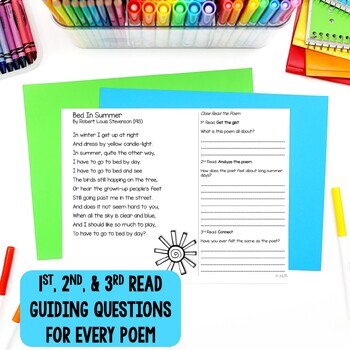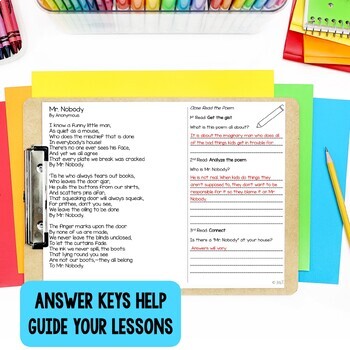Close Reading Poems | National Poetry Month: Printable & Digital Formats
- PDF
- Google Apps™

What educators are saying
Description
This resource is perfect for close reading poems for National Poetry Month in April!
But, poetry doesn't have to be saved for April! Use this pack to practice close reading poems in your classroom to help grow your students' love for poetry.
This resource is designed to help teachers engage students with classic poetry through guiding questions during multiple reads.
With three questions to guide different purposes for reading each of the twelve poems, you'll be set to apply a variety of reading skills to poetry. Your students will learn to unpack the meaning of each poem and gain a deeper appreciation for the power of language!
This file includes the digital and printable versions of the poetry activities.
Included in this pack:
Suggestions for use, Annotation Bookmarks, and the following poems found in the public domain with guiding questions (and answer keys) for the first, second, and third read:
In August By William Dean Howells (1902)
Bed In Summer By Robert Louis Stevenson (1913)
*can be paired with a text about the seasons or Daylight Savings Time
The Spider By Jane Taylor (1883)
November By Alice Cary (1873)
Snow-Flakes By Fannie Isabelle Sherrick (1880)
Mr. Nobody By Anonymous
My Shadow By Robert Louis Stevenson (1885)
*can be tied with Groundhog Day or a study about light
The Brook By Alfred, Lord Tennyson (1862)
Woodman, Spare That Tree! By George Pope Morris (1830)
A Riddle By Hannah More (1818)
Verse for a Certain Dog by Dorothy Parker (1926)
Mother to Son by Langston Hughes (1922)
Check out my blog post that shows a step-by-step lesson using a poem from this pack (including a freebie), as well as this SECOND post that includes a BONUS poem!
*****************************************************************************
Want more information on how to implement close reading in your classroom?
You can check out these other blog posts:
Stop Highlighting...Start Thinking!
Text Dependent Questions With Annotations
Text Dependent Questions, Part 2
*****************************************************************************
Please remember, this purchase is for the use of one teacher. It is not intended to be shared. Please use the 'additional license' purchase if more than one teacher will be using it. Thank you!
Copyright © Ideas By Jivey, LLC
All rights reserved by author, Jessica Ivey.
Permission to copy for single classroom use only.
Electronic distribution limited to single classroom use only.
Not for public display.
Leave feedback to earn credits for future purchases! Become a follower to receive updates about future units as well!





